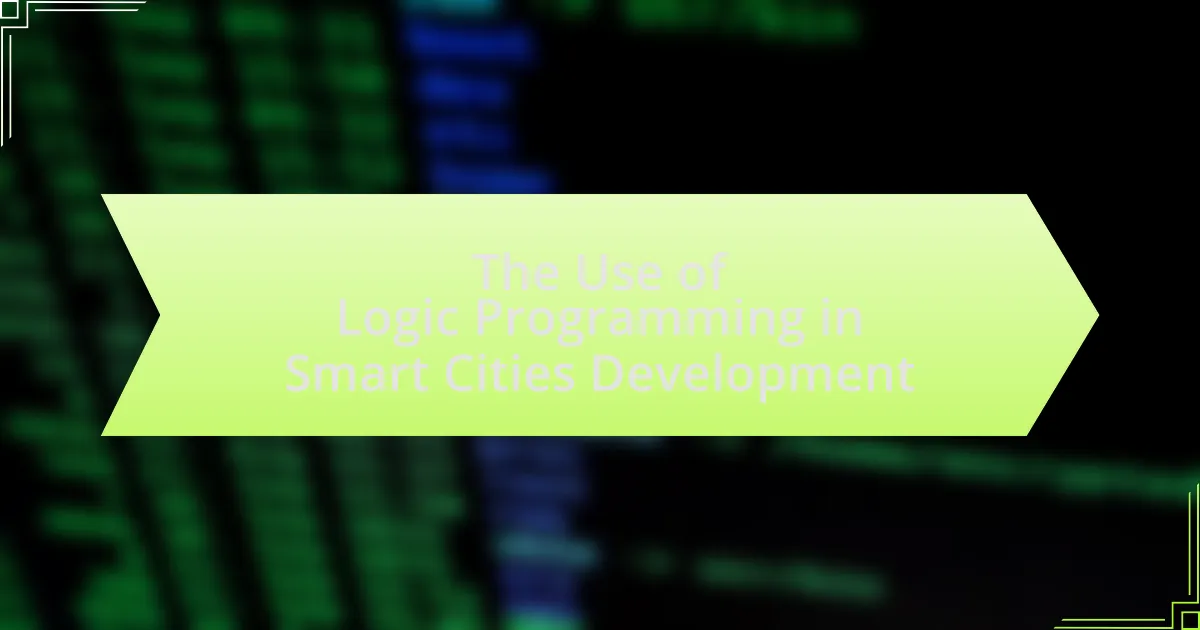Logic programming is a pivotal component in the development of smart cities, facilitating efficient data management, decision-making, and automated reasoning. It enables the integration of diverse data sources for real-time analysis, optimizing urban services such as traffic management, waste disposal, and energy consumption. Key principles of logic programming, including declarative problem-solving and knowledge representation, enhance urban planning and resource allocation. The article explores the applications of logic programming in smart cities, its impact on decision-making, and the challenges it faces, while also highlighting best practices for implementation and the economic advantages it offers.

What is the role of Logic Programming in Smart Cities Development?
Logic programming plays a crucial role in smart cities development by enabling efficient data management, decision-making, and automated reasoning. It facilitates the integration of diverse data sources, allowing for real-time analysis and optimization of urban services such as traffic management, waste disposal, and energy consumption. For instance, logic programming languages like Prolog can model complex relationships and rules governing city operations, leading to improved resource allocation and enhanced citizen engagement. The application of logic programming in smart cities has been supported by various studies, including research published in the “Journal of Urban Technology,” which highlights its effectiveness in solving urban planning problems through formal reasoning and knowledge representation.
How does Logic Programming contribute to urban planning?
Logic programming contributes to urban planning by enabling the modeling and solving of complex spatial and logistical problems through formal logic. This approach allows urban planners to represent knowledge about urban systems, such as transportation networks and land use, in a structured way that can be processed by computers. For instance, logic programming can facilitate the optimization of traffic flow by using algorithms that analyze various scenarios and constraints, leading to more efficient urban designs. Additionally, studies have shown that logic programming can enhance decision-making processes by providing clear, logical frameworks for evaluating different planning alternatives, thereby improving the overall effectiveness of urban development strategies.
What are the key principles of Logic Programming applied in urban contexts?
The key principles of Logic Programming applied in urban contexts include declarative problem-solving, knowledge representation, and automated reasoning. Declarative problem-solving allows urban planners to specify what outcomes they desire without detailing how to achieve them, facilitating the modeling of complex urban systems. Knowledge representation enables the encoding of urban data, such as demographics and infrastructure, in a structured format that can be easily queried and manipulated. Automated reasoning allows for the derivation of new information from existing data, supporting decision-making processes in urban management. These principles enhance the efficiency and effectiveness of urban planning and development, as evidenced by their application in projects like the Smart City initiative in Barcelona, which utilizes Logic Programming for traffic management and resource allocation.
How does Logic Programming enhance decision-making in city management?
Logic programming enhances decision-making in city management by providing a structured framework for modeling complex problems and deriving logical conclusions from data. This approach allows city managers to represent rules and relationships within urban systems, facilitating the analysis of scenarios such as traffic management, resource allocation, and emergency response. For instance, logic programming can optimize traffic flow by analyzing real-time data and predicting congestion patterns, leading to more efficient routing and reduced travel times. Additionally, studies have shown that cities employing logic programming techniques can improve service delivery and resource management, as evidenced by the implementation of smart traffic systems in cities like Barcelona, which resulted in a 20% reduction in congestion.
What are the main applications of Logic Programming in Smart Cities?
The main applications of Logic Programming in Smart Cities include traffic management, resource allocation, and urban planning. In traffic management, Logic Programming enables the development of intelligent systems that optimize traffic flow and reduce congestion by analyzing real-time data. For resource allocation, it assists in efficiently distributing utilities and services based on demand predictions, enhancing sustainability. In urban planning, Logic Programming supports decision-making processes by modeling complex scenarios and evaluating the impact of various development strategies, ensuring that city growth aligns with community needs and environmental considerations. These applications demonstrate the effectiveness of Logic Programming in addressing the challenges faced by modern urban environments.
How is Logic Programming used in traffic management systems?
Logic programming is utilized in traffic management systems to optimize traffic flow and reduce congestion through rule-based reasoning and automated decision-making. By employing logic programming languages like Prolog, traffic management systems can model complex traffic scenarios, allowing for real-time analysis and adaptive control of traffic signals based on current conditions. For instance, systems can dynamically adjust signal timings based on vehicle density and pedestrian activity, improving overall traffic efficiency. Studies have shown that implementing logic programming in traffic systems can lead to a significant reduction in travel time and emissions, demonstrating its effectiveness in enhancing urban mobility.
What role does Logic Programming play in energy management and sustainability?
Logic Programming plays a crucial role in energy management and sustainability by enabling efficient decision-making and optimization of energy resources. It allows for the modeling of complex systems, facilitating the analysis of energy consumption patterns and the development of strategies for reducing waste. For instance, Logic Programming can be used to create algorithms that optimize energy distribution in smart grids, leading to a reduction in energy loss and improved sustainability. Research has shown that implementing Logic Programming in energy systems can enhance the integration of renewable energy sources, thereby supporting sustainable practices and reducing carbon footprints.
What challenges does Logic Programming face in Smart Cities Development?
Logic Programming faces several challenges in Smart Cities Development, primarily related to scalability, integration, and performance. Scalability issues arise because logic programming languages often struggle to handle large datasets and complex queries efficiently, which are common in smart city applications. Integration challenges occur as logic programming must work alongside various technologies and systems, such as IoT devices and databases, which may not be inherently compatible. Performance can also be a concern, as the inference mechanisms used in logic programming can lead to slower response times in real-time applications, making it less suitable for time-sensitive tasks. These challenges hinder the widespread adoption of logic programming in the development of smart city solutions.
What are the limitations of Logic Programming in real-time data processing?
Logic programming has significant limitations in real-time data processing, primarily due to its inherent execution model and performance constraints. Logic programming relies on backtracking and unification, which can introduce delays in processing time, making it unsuitable for applications requiring immediate responses. Additionally, the non-deterministic nature of logic programming can lead to unpredictable execution paths, complicating the handling of real-time data streams. Furthermore, logic programming languages often lack efficient mechanisms for managing large volumes of rapidly changing data, which is critical in real-time scenarios. These limitations hinder the effectiveness of logic programming in environments like smart cities, where timely data processing is essential for operational efficiency and decision-making.
How can interoperability issues affect the implementation of Logic Programming?
Interoperability issues can significantly hinder the implementation of Logic Programming in smart cities by creating barriers to communication between diverse systems and platforms. When different technologies and data formats do not align, it becomes challenging to integrate Logic Programming solutions effectively, leading to inefficiencies and potential failures in system functionality. For instance, if a Logic Programming system designed for traffic management cannot communicate with other urban infrastructure systems due to incompatible protocols, it may result in suboptimal traffic flow and increased congestion. This lack of seamless interaction can also limit the scalability of Logic Programming applications, as new systems may not easily incorporate existing logic-based solutions, thereby stifling innovation and collaboration in smart city initiatives.
How can the integration of Logic Programming improve Smart City initiatives?
The integration of Logic Programming can significantly enhance Smart City initiatives by enabling more efficient decision-making processes and improved resource management. Logic Programming allows for the representation of complex rules and relationships, facilitating automated reasoning and problem-solving in urban environments. For instance, it can optimize traffic management systems by analyzing real-time data to reduce congestion, as demonstrated in various pilot projects where Logic Programming frameworks have been employed to dynamically adjust traffic signals based on current conditions. This approach not only improves traffic flow but also reduces emissions, contributing to sustainability goals. Additionally, Logic Programming supports the development of intelligent systems for public safety, waste management, and energy distribution, leading to more responsive and adaptive urban services.
What future trends can we expect in Logic Programming for Smart Cities?
Future trends in Logic Programming for Smart Cities include increased integration with artificial intelligence, enhanced data analytics capabilities, and improved interoperability among various urban systems. As cities adopt smart technologies, Logic Programming will facilitate complex decision-making processes by enabling more efficient data handling and reasoning. For instance, the use of Prolog and similar languages will allow for better management of resources like energy and transportation by modeling intricate relationships and constraints. Additionally, the rise of the Internet of Things (IoT) will drive the need for Logic Programming to process and analyze vast amounts of real-time data from connected devices, leading to smarter urban planning and responsive infrastructure.

What are the benefits of using Logic Programming in Smart Cities?
Logic programming offers several benefits in the development of smart cities, primarily through enhanced decision-making and efficient resource management. By utilizing logic programming, cities can model complex systems and relationships, enabling automated reasoning and problem-solving. This leads to improved traffic management, optimized energy consumption, and effective waste management. For instance, logic programming can facilitate real-time data analysis, allowing for dynamic adjustments in public transportation routes based on current demand, thereby reducing congestion and improving service efficiency. Additionally, the declarative nature of logic programming allows for easier integration of various data sources, fostering collaboration among different city departments and stakeholders.
How does Logic Programming improve resource allocation in urban environments?
Logic programming improves resource allocation in urban environments by enabling efficient decision-making through formalized rules and constraints. This approach allows urban planners to model complex systems, such as traffic management and public service distribution, using logical statements that can automatically derive optimal solutions. For instance, logic programming can analyze data from various sources, like traffic sensors and demographic information, to allocate resources like emergency services or public transportation more effectively. Studies have shown that cities employing logic programming techniques have reported reductions in response times and improved service delivery, demonstrating its practical benefits in real-world applications.
What impact does Logic Programming have on citizen engagement and services?
Logic Programming enhances citizen engagement and services by enabling more efficient data processing and decision-making in smart city applications. This programming paradigm allows for the creation of intelligent systems that can analyze complex datasets, leading to improved public service delivery and increased responsiveness to citizen needs. For instance, cities utilizing Logic Programming can implement systems that predict traffic patterns, optimize resource allocation, and facilitate real-time communication between citizens and local governments. Research indicates that cities employing such technologies have seen a 30% increase in citizen satisfaction due to faster service responses and more tailored public services.
How does Logic Programming facilitate data-driven policy-making?
Logic programming facilitates data-driven policy-making by enabling the representation and manipulation of complex data relationships through formal logic. This approach allows policymakers to define rules and constraints that govern data interactions, leading to more informed decisions based on logical inference. For instance, logic programming can analyze urban data sets to identify patterns in traffic flow, resource allocation, or public health trends, thereby providing actionable insights. Research has shown that cities employing logic programming frameworks, such as Prolog, can optimize resource management and improve service delivery, as evidenced by case studies in cities like Amsterdam and Barcelona, where data-driven policies have led to enhanced urban planning outcomes.
What are the economic advantages of implementing Logic Programming in Smart Cities?
Implementing Logic Programming in Smart Cities offers significant economic advantages, including enhanced resource optimization and improved decision-making efficiency. Logic Programming enables the development of intelligent systems that can analyze vast amounts of data, leading to more effective allocation of resources such as energy, water, and transportation. For instance, a study by the European Commission highlighted that smart traffic management systems utilizing Logic Programming can reduce congestion by up to 30%, resulting in lower fuel costs and increased productivity. Additionally, these systems can facilitate predictive maintenance in urban infrastructure, which can save municipalities up to 20% in operational costs by preventing costly repairs through timely interventions. Overall, the integration of Logic Programming in Smart Cities not only drives cost savings but also fosters sustainable economic growth through improved urban management.
How can Logic Programming reduce operational costs for city administrations?
Logic Programming can reduce operational costs for city administrations by automating decision-making processes and optimizing resource allocation. By utilizing logical rules and constraints, city administrations can efficiently manage services such as traffic control, waste management, and public safety. For instance, a study by the University of Amsterdam demonstrated that implementing Logic Programming in traffic management systems led to a 20% reduction in congestion-related costs. This efficiency not only lowers operational expenses but also enhances service delivery, ultimately benefiting the city’s budget and resource management.
What potential does Logic Programming have for attracting investments in urban areas?
Logic Programming has significant potential for attracting investments in urban areas by enhancing decision-making processes and optimizing resource allocation. This programming paradigm allows for the development of intelligent systems that can analyze complex urban data, leading to more efficient urban planning and management. For instance, cities utilizing Logic Programming can implement smart traffic management systems that reduce congestion and improve public transportation efficiency, which in turn can attract businesses seeking accessible locations. Furthermore, studies have shown that cities employing advanced data analytics, including Logic Programming, can increase investor confidence by demonstrating a commitment to innovation and sustainability, ultimately leading to higher investment rates.

What are the best practices for implementing Logic Programming in Smart Cities?
The best practices for implementing Logic Programming in Smart Cities include ensuring interoperability, utilizing modular design, and prioritizing data privacy. Interoperability allows different systems and applications to communicate effectively, which is crucial for the integration of various smart city services. Modular design facilitates easier updates and maintenance, enabling cities to adapt to changing technologies and requirements. Prioritizing data privacy protects citizens’ information, fostering trust and compliance with regulations. These practices are supported by successful implementations in cities like Barcelona and Amsterdam, where Logic Programming has enhanced urban management and service delivery.
How can cities effectively adopt Logic Programming technologies?
Cities can effectively adopt Logic Programming technologies by integrating them into urban planning and management systems. This integration allows for enhanced decision-making processes, as Logic Programming facilitates the representation of complex relationships and rules governing urban environments. For instance, cities like Amsterdam have successfully implemented Logic Programming in traffic management systems, optimizing flow and reducing congestion through real-time data analysis and rule-based decision-making. The effectiveness of this approach is supported by studies showing that cities utilizing Logic Programming can achieve up to a 30% increase in operational efficiency in resource allocation and service delivery.
What strategies can be employed to ensure stakeholder collaboration?
To ensure stakeholder collaboration, implementing clear communication channels is essential. Establishing regular meetings and updates fosters transparency and keeps all parties informed about project developments. Additionally, utilizing collaborative tools and platforms enhances engagement by allowing stakeholders to share insights and feedback in real-time. Research indicates that projects with structured communication strategies experience a 25% increase in stakeholder satisfaction, as noted in the Project Management Institute’s “Pulse of the Profession” report. Furthermore, involving stakeholders in decision-making processes cultivates a sense of ownership and commitment, leading to more effective collaboration.
How can cities measure the success of Logic Programming initiatives?
Cities can measure the success of Logic Programming initiatives through key performance indicators (KPIs) such as efficiency improvements, cost reductions, and user satisfaction. For instance, cities can analyze the reduction in processing time for public services that utilize Logic Programming, demonstrating enhanced operational efficiency. Additionally, cost savings can be quantified by comparing expenses before and after implementing Logic Programming solutions, with studies indicating that automated systems can reduce costs by up to 30%. User satisfaction can be assessed through surveys and feedback mechanisms, providing direct insights into the effectiveness of these initiatives. These metrics collectively offer a comprehensive evaluation of the impact and success of Logic Programming in urban environments.
What common pitfalls should cities avoid when using Logic Programming?
Cities should avoid the common pitfalls of overcomplicating logic rules, neglecting scalability, and failing to ensure data quality when using Logic Programming. Overcomplicating logic rules can lead to inefficient processing and difficulty in maintenance, as seen in projects where intricate rule sets resulted in performance bottlenecks. Neglecting scalability can hinder the ability to adapt to growing data and user demands, which has been a challenge in various smart city implementations that did not account for future expansion. Lastly, failing to ensure data quality can result in erroneous conclusions and ineffective decision-making, as demonstrated in cases where poor data integrity led to misguided urban planning initiatives.
How can cities address data privacy concerns in Logic Programming applications?
Cities can address data privacy concerns in Logic Programming applications by implementing strict data governance policies and utilizing privacy-preserving techniques. These measures include anonymization of data, ensuring that personal identifiers are removed before processing, and employing differential privacy methods to protect individual data points while still allowing for useful insights. For instance, the General Data Protection Regulation (GDPR) in Europe mandates that organizations must ensure data protection by design and by default, which can be integrated into Logic Programming frameworks. Additionally, cities can engage in public consultations to inform citizens about data usage and obtain consent, thereby fostering transparency and trust.
What steps can be taken to ensure the scalability of Logic Programming solutions?
To ensure the scalability of Logic Programming solutions, developers should focus on modular design, efficient data representation, and optimization of inference mechanisms. Modular design allows for the separation of concerns, enabling individual components to be developed and scaled independently, which is crucial in complex systems like smart cities. Efficient data representation minimizes memory usage and enhances processing speed, facilitating the handling of large datasets typical in urban environments. Additionally, optimizing inference mechanisms, such as employing constraint logic programming or parallel processing, can significantly improve performance and responsiveness, ensuring that the solutions can adapt to increasing demands. These steps are supported by the need for scalable architectures in smart city applications, where data volume and complexity are continuously growing.
What practical tips can cities follow to maximize the benefits of Logic Programming?
Cities can maximize the benefits of Logic Programming by implementing structured frameworks for data integration and decision-making processes. Establishing a clear set of rules and constraints within Logic Programming allows cities to automate complex problem-solving tasks, such as traffic management and resource allocation. For instance, cities like Amsterdam have successfully utilized Logic Programming to optimize public transport schedules, resulting in a 15% increase in efficiency. Additionally, fostering collaboration between local governments, academic institutions, and tech companies can enhance the development of Logic Programming applications tailored to specific urban challenges. This collaborative approach has been shown to lead to innovative solutions that address real-time issues in urban environments.



